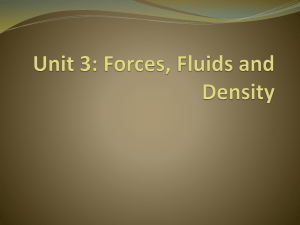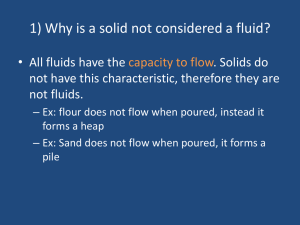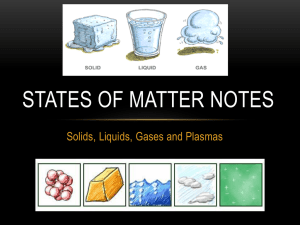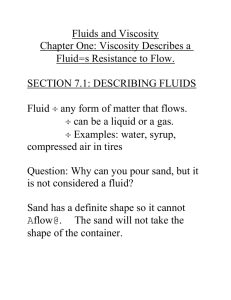Science 8
advertisement
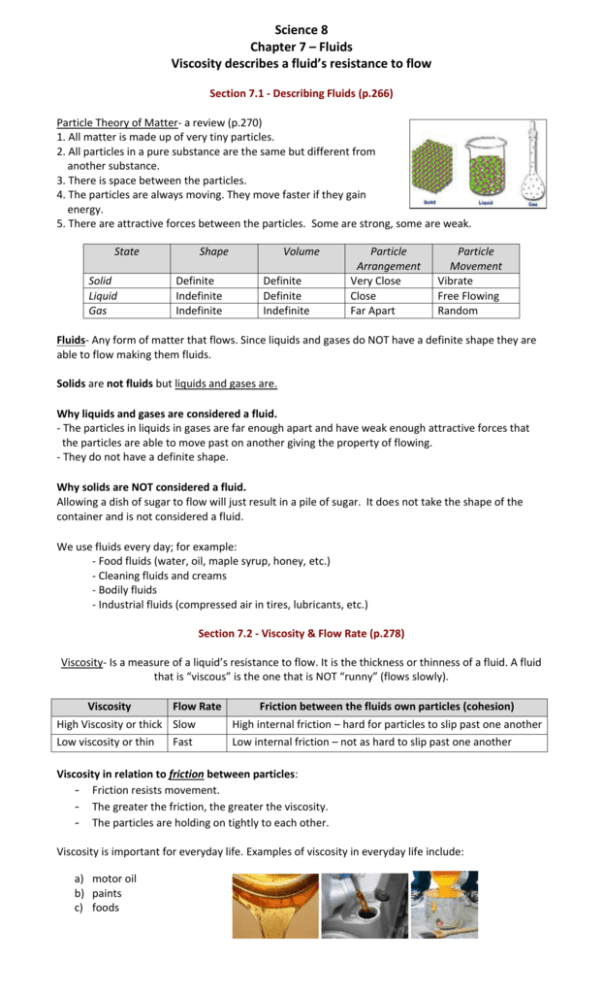
Science 8 Chapter 7 – Fluids Viscosity describes a fluid’s resistance to flow Section 7.1 - Describing Fluids (p.266) Particle Theory of Matter- a review (p.270) 1. All matter is made up of very tiny particles. 2. All particles in a pure substance are the same but different from another substance. 3. There is space between the particles. 4. The particles are always moving. They move faster if they gain energy. 5. There are attractive forces between the particles. Some are strong, some are weak. State Solid Liquid Gas Shape Definite Indefinite Indefinite Volume Definite Definite Indefinite Particle Arrangement Very Close Close Far Apart Particle Movement Vibrate Free Flowing Random Fluids- Any form of matter that flows. Since liquids and gases do NOT have a definite shape they are able to flow making them fluids. Solids are not fluids but liquids and gases are. Why liquids and gases are considered a fluid. - The particles in liquids in gases are far enough apart and have weak enough attractive forces that the particles are able to move past on another giving the property of flowing. - They do not have a definite shape. Why solids are NOT considered a fluid. Allowing a dish of sugar to flow will just result in a pile of sugar. It does not take the shape of the container and is not considered a fluid. We use fluids every day; for example: - Food fluids (water, oil, maple syrup, honey, etc.) - Cleaning fluids and creams - Bodily fluids - Industrial fluids (compressed air in tires, lubricants, etc.) Section 7.2 - Viscosity & Flow Rate (p.278) Viscosity- Is a measure of a liquid’s resistance to flow. It is the thickness or thinness of a fluid. A fluid that is “viscous” is the one that is NOT “runny” (flows slowly). Viscosity Flow Rate Friction between the fluids own particles (cohesion) High Viscosity or thick Slow High internal friction – hard for particles to slip past one another Low viscosity or thin Fast Low internal friction – not as hard to slip past one another Viscosity in relation to friction between particles: - Friction resists movement. - The greater the friction, the greater the viscosity. - The particles are holding on tightly to each other. Viscosity is important for everyday life. Examples of viscosity in everyday life include: a) motor oil b) paints c) foods Flow Rate - The speed at which a fluid flows from one point to another. - Slow: Corn Syrup - Medium: Dishwashing Liquid - Fast: Water Section 7.3 Factors Affecting Viscosity (p.286) Factors that affect the viscosity of a liquid: 1. Temperature- As you increase temperature, you decrease a fluid’s viscosity. As you decrease temperature, you increase a fluid’s viscosity. Heat is added to a liquid particles move faster and further apart. This means there is less friction and reduced attractive forces, thus, liquid has a lower viscosity and thinner as a result Example: Wax or Honey is heated they become thinner. The opposite is true of gases. Why? When heat is added to a gas (note particles are already far apart), particles speed up and actually cause more collisions than before. There is an increase in internal friction. Gas has a higher viscosity and thicker as a result. 2. Concentration- The amount of a substance dissolved in a specific volume. Increasing the concentration increases the viscosity. For example: Four teaspoons of sugar in a cup of water is concentrated. One teaspoon in a cup of water is less concentrated (dilute). More concentrated = more particles = higher Viscosity Less concentrated = less particles = lower viscosity 3. Attractive Force- If the attractive forces are strong, it is difficult for the particles to pull away. Therefore, the fluid flows slowly and is more viscous. Basically, the stronger the bonds between particles, the higher the viscosity. Thus, the harder it will be for them to slip past one another. The weaker the bonds, the lower the viscosity 4. Particle Size- The smaller the particle size, the faster the fluid flows and is less viscous. Size (Shape) Size usually means complexity here. Usually the larger the particle the more complex it is. More complex (larger) = higher viscosity Less complex (smaller) = lower viscosity Think of more complex particles like jacks and less complex like marbles. The jacks have a much harder time slipping past one another and hence would be thick. Jacks Marbles


